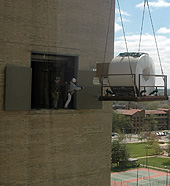Whether it’s needed to track the activity of a drug, the growth of a tumor or the progress of a medical disorder, high-tech imaging equipment often is an essential component of advanced clinical research.
Unfortunately, patient care typically keeps these machines and the doctors who run them jammed with activity, often making it necessary to fit in research activities late at night or on the weekends.
School of Medicine researchers and administrators are taking a new approach: They have created a multimillion-dollar imaging facility in the heart of Barnes-Jewish Hospital that is dedicated to scientific research.

“The Center for Clinical Imaging Research (CCIR) is available for research 24 hours a day, seven days a week, and that just opens up all kinds of possibilities,” said R. Gilbert Jost, M.D., the Elizabeth E. Mallinckrodt Professor of Radiology and head of the Mallinckrodt Institute of Radiology (MIR). The Institute held the top spot in National Institutes of Health research funding of radiology departments in the fiscal years 2005 and 2006, and its 427 academic employees make it one of the largest radiology departments in the nation.
The 9,000-square-foot CCIR, on the 10th floor of the West Pavilion of Barnes-Jewish Hospital, provides a comprehensive selection of the latest state-of-the-art imaging equipment, including high-resolution positron emission tomography (PET), three-dimensional ultrasound, high-powered magnetic resonance imaging (MRI), 64-slice computed tomography (CT) and advanced PET-CT scanners.
“Radiology provides clinical-imaging services for all the departments in the medical school, and our goal for CCIR is to provide that same kind of broad support for research programs in every department,” said Mark Mintun, M.D., professor of radiology, director of the center and director of the Division of Research Development at MIR.
“Barnes-Jewish Hospital is pleased to be the site of this unique facility,” said Andrew A. Ziskind, M.D., president of Barnes-Jewish Hospital. “I don’t know of any other institution that has committed to providing researchers with the full spectrum of clinical imaging equipment located within a hospital, thereby making it possible to study both inpatients as well as outpatients.”
Inspiration and support for CCIR came from the BioMed 21 program, a University-wide initiative dedicated to accelerating the development of basic science discoveries into new and improved patient treatments.
“Through this center, researchers from many departments will be working to expand the application of existing scanning techniques to better understand the disease process, improve and accelerate disease diagnosis and assess the effects of treatment,” said Larry J. Shapiro, M.D., executive vice chancellor for medical affairs and dean of the School of Medicine.

“Scientists are also creating innovative imaging approaches that open up new avenues for insight at scales ranging from the interactions of individual molecules to the activity of complete biological systems. An essential ingredient of the BioMed 21 philosophy is the encouragement and support of collaborations between researchers from multiple scientific disciplines,” Shapiro said.
To highlight the potential impact of CCIR, Jost said a PET scanner for research placed in the neuro-intensive care unit at Barnes-Jewish nine years ago has led to more than 30 research grants involving 14 scientists from five different medical school departments. Jost attributed that unit’s productivity to its proximity to patients at Barnes-Jewish and to clinical researchers who were able to spend time on research without departing the hospital.
“That was an investment of a few million dollars that turned into over $48 million in direct reimbursements for research costs,” Jost said. “Placing a comprehensive selection of clinical imaging equipment in the hospital environment provides us with an enormous opportunity to expand our clinical research programs.”
In addition to opportunities to increase federally funded research, Jost said he believes the CCIR will likely stimulate new scientific support from industry and new training opportunities.
“The CCIR provides a laboratory where research fellows can help manufacturers assess in real time whether new drugs, imaging contrast agents or image analysis software are working,” Jost said.
“If we, for example, had a new anti-tumor drug, in the old days, we could only test it by giving the drug and then waiting months or years to see who had lived and who had died. But by using modern imaging techniques, we sometimes can evaluate the impact of the drug within a much shorter time period — a few days or even a few hours.”